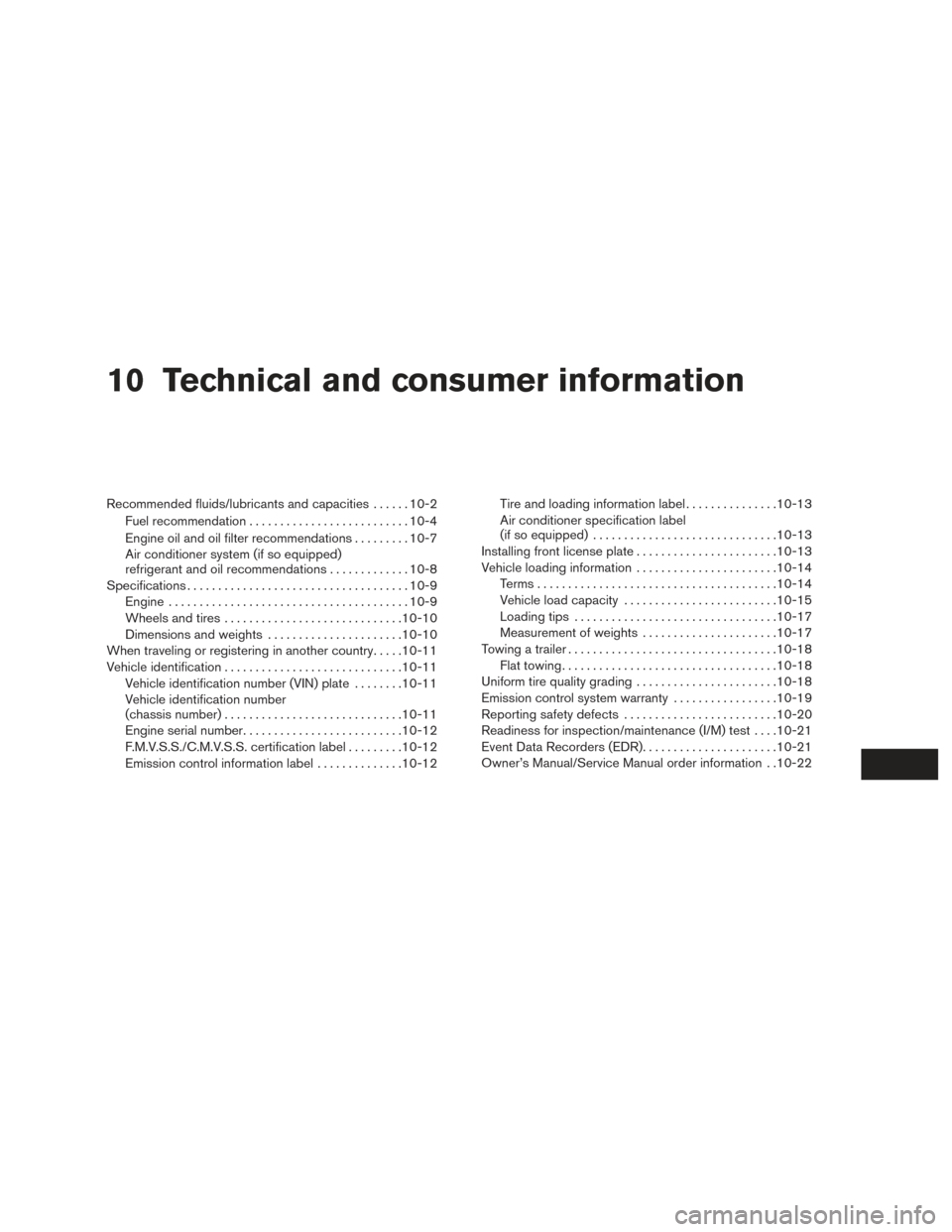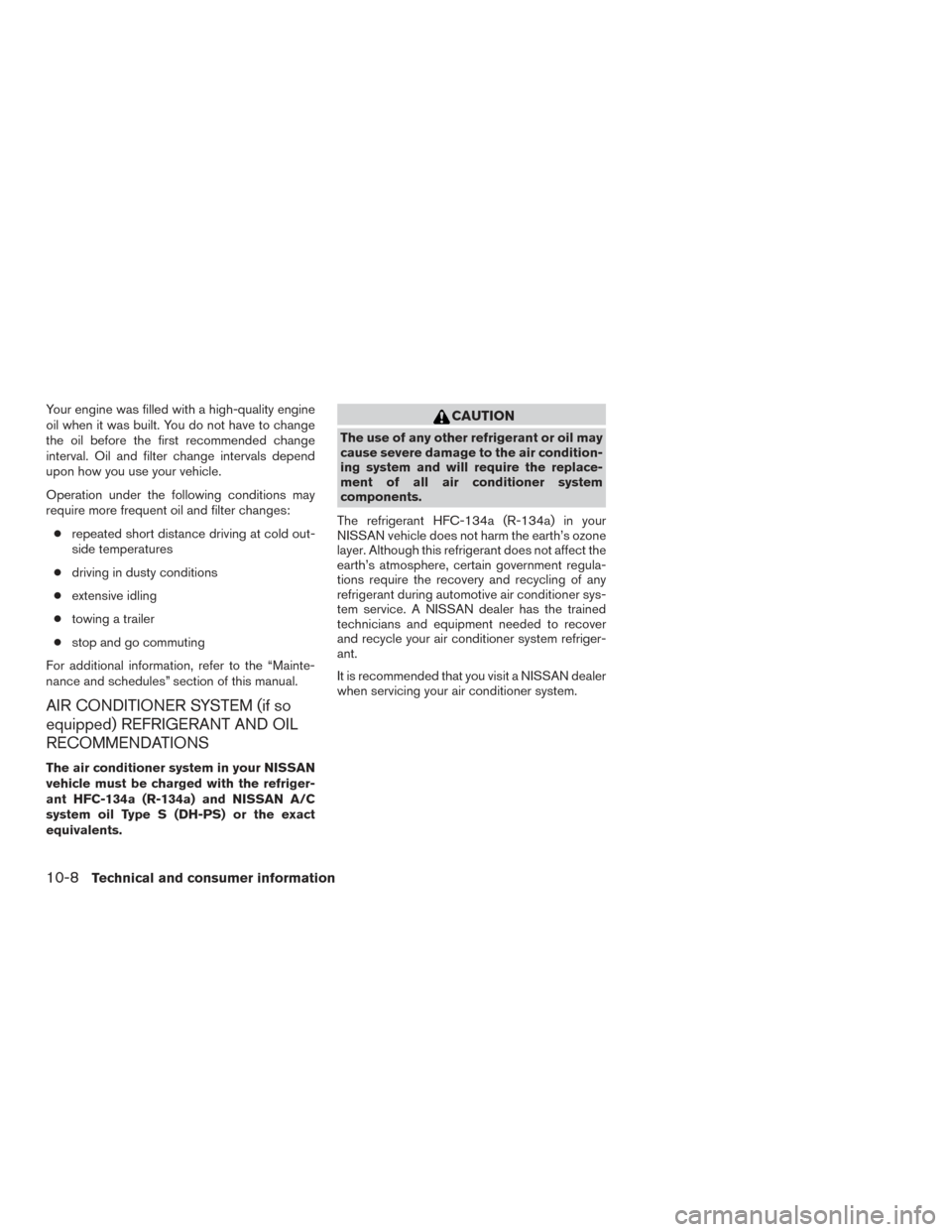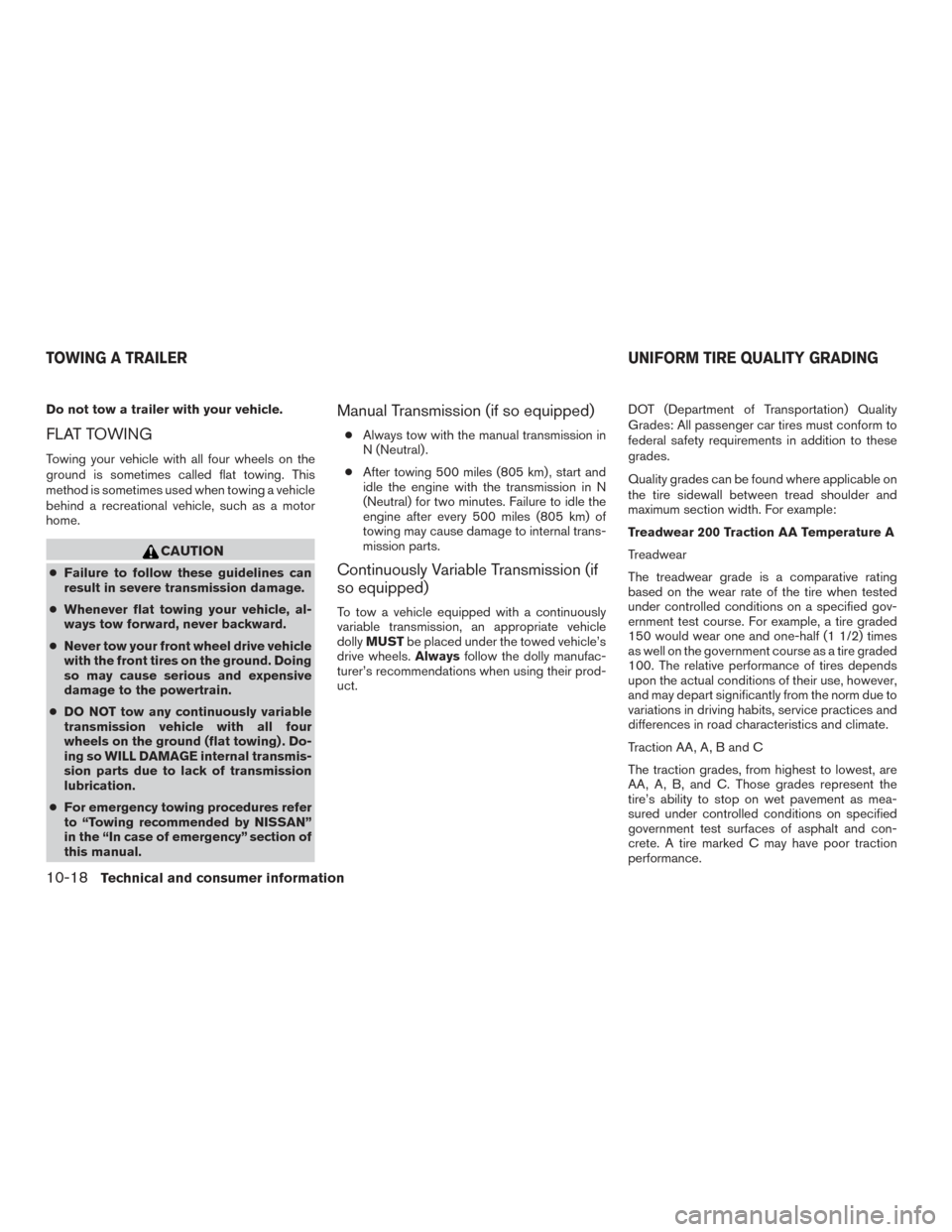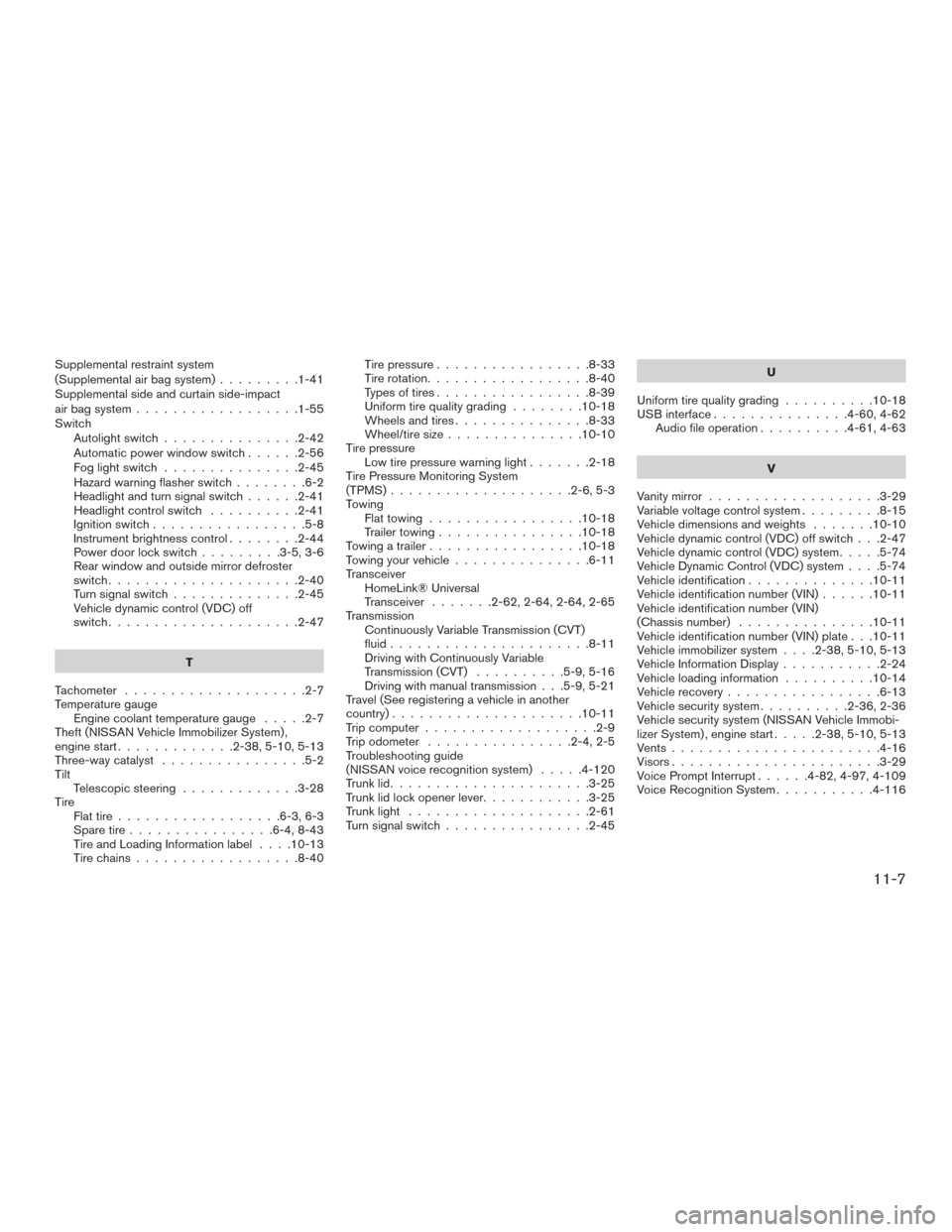2017 NISSAN SENTRA towing
[x] Cancel search: towingPage 460 of 491

10 Technical and consumer information
Recommended fluids/lubricants and capacities......10-2
Fuel recommendation .......................... 10-4
Engine oil and oil filter recommendations .........10-7
Air conditioner system (if so equipped)
refrigerant and oil recommendations .............10-8
Specifications .................................... 10-9
Engine ....................................... 10-9
Wheels and tires ............................. 10-10
Dimensions and weights ......................10-10
When traveling or registering in another country .....10-11
Vehicle identification ............................. 10-11
Vehicle identification number (VIN) plate ........10-11
Vehicle identification number
(chassis number) ............................. 10-11
Engine serial number .......................... 10-12
F.M.V.S.S./C.M.V.S.S. certification label .........10-12
Emission control information label ..............10-12 Tire and loading information label
...............10-13
Air conditioner specification label
(if so equipped) .............................. 10-13
Installing front license plate .......................10-13
Vehicle loading information .......................10-14
Terms ....................................... 10-14
Vehicle load capacity ......................... 10-15
Loading tips ................................. 10-17
Measurement of weights ......................10-17
Towing a trailer .................................. 10-18
Flat towing ................................... 10-18
Uniform tire quality grading .......................10-18
Emission control system warranty .................10-19
Reporting safety defects ......................... 10-20
Readiness for inspection/maintenance (I/M) test ....10-21
Event Data Recorders (EDR) ......................10-21
Owner’s Manual/Service Manual order information . .10-22
Page 467 of 491

Your engine was filled with a high-quality engine
oil when it was built. You do not have to change
the oil before the first recommended change
interval. Oil and filter change intervals depend
upon how you use your vehicle.
Operation under the following conditions may
require more frequent oil and filter changes:● repeated short distance driving at cold out-
side temperatures
● driving in dusty conditions
● extensive idling
● towing a trailer
● stop and go commuting
For additional information, refer to the “Mainte-
nance and schedules” section of this manual.
AIR CONDITIONER SYSTEM (if so
equipped) REFRIGERANT AND OIL
RECOMMENDATIONS
The air conditioner system in your NISSAN
vehicle must be charged with the refriger-
ant HFC-134a (R-134a) and NISSAN A/C
system oil Type S (DH-PS) or the exact
equivalents.
CAUTION
The use of any other refrigerant or oil may
cause severe damage to the air condition-
ing system and will require the replace-
ment of all air conditioner system
components.
The refrigerant HFC-134a (R-134a) in your
NISSAN vehicle does not harm the earth’s ozone
layer. Although this refrigerant does not affect the
earth’s atmosphere, certain government regula-
tions require the recovery and recycling of any
refrigerant during automotive air conditioner sys-
tem service. A NISSAN dealer has the trained
technicians and equipment needed to recover
and recycle your air conditioner system refriger-
ant.
It is recommended that you visit a NISSAN dealer
when servicing your air conditioner system.
10-8Technical and consumer information
Page 477 of 491

Do not tow a trailer with your vehicle.
FLAT TOWING
Towing your vehicle with all four wheels on the
ground is sometimes called flat towing. This
method is sometimes used when towing a vehicle
behind a recreational vehicle, such as a motor
home.
CAUTION
●Failure to follow these guidelines can
result in severe transmission damage.
● Whenever flat towing your vehicle, al-
ways tow forward, never backward.
● Never tow your front wheel drive vehicle
with the front tires on the ground. Doing
so may cause serious and expensive
damage to the powertrain.
● DO NOT tow any continuously variable
transmission vehicle with all four
wheels on the ground (flat towing) . Do-
ing so WILL DAMAGE internal transmis-
sion parts due to lack of transmission
lubrication.
● For emergency towing procedures refer
to “Towing recommended by NISSAN”
in the “In case of emergency” section of
this manual.
Manual Transmission (if so equipped)
● Always tow with the manual transmission in
N (Neutral) .
● After towing 500 miles (805 km) , start and
idle the engine with the transmission in N
(Neutral) for two minutes. Failure to idle the
engine after every 500 miles (805 km) of
towing may cause damage to internal trans-
mission parts.
Continuously Variable Transmission (if
so equipped)
To tow a vehicle equipped with a continuously
variable transmission, an appropriate vehicle
dolly MUST be placed under the towed vehicle’s
drive wheels. Alwaysfollow the dolly manufac-
turer’s recommendations when using their prod-
uct. DOT (Department of Transportation) Quality
Grades: All passenger car tires must conform to
federal safety requirements in addition to these
grades.
Quality grades can be found where applicable on
the tire sidewall between tread shoulder and
maximum section width. For example:
Treadwear 200 Traction AA Temperature A
Treadwear
The treadwear grade is a comparative rating
based on the wear rate of the tire when tested
under controlled conditions on a specified gov-
ernment test course. For example, a tire graded
150 would wear one and one-half (1 1/2) times
as well on the government course as a tire graded
100. The relative performance of tires depends
upon the actual conditions of their use, however,
and may depart significantly from the norm due to
variations in driving habits, service practices and
differences in road characteristics and climate.
Traction AA, A, B and C
The traction grades, from highest to lowest, are
AA, A, B, and C. Those grades represent the
tire’s ability to stop on wet pavement as mea-
sured under controlled conditions on specified
government test surfaces of asphalt and con-
crete. A tire marked C may have poor traction
performance.
TOWING A TRAILER
UNIFORM TIRE QUALITY GRADING
10-18Technical and consumer information
Page 488 of 491

Supplemental restraint system
(Supplemental air bag system).........1-41
Supplemental side and curtain side-impact
air bag system ..................1-55
Switch Autolightswitch...............2-42
Automatic power window switch ......2-56
Foglightswitch ...............2-45
Hazard warning flasher switch ........6-2
Headlight and turn signal switch ......2-41
Headlight control switch ..........2-41
Ignition switch .................5-8
Instrument brightness control ........2-44
Power door lock switch .........3-5,3-6
Rear window and outside mirror defroster
switch.....................2-40
Turnsignalswitch..............2-45
Vehicle dynamic control (VDC) off
switch.....................2-47
T
Tachometer ....................2-7
Temperature gauge Engine coolant temperature gauge .....2-7
Theft (NISSAN Vehicle Immobilizer System) ,
engine start .............2-38,5-10,5-13
Three-way catalyst ................5-2
Tilt Telescopic steering .............3-28
Tire Flat tire ..................6-3,6-3
Spare tire ................6-4,8-43
TireandLoadingInformationlabel ....10-13
Tire chains ..................8-40 Tirepressure.................8-33
Tire rotation..................8-40
Types of tires
.................8-39
Uniform tire quality grading ........10-18
Wheels and tires ...............8-33
Wheel/tire size ...............10-10
Tire pressure Low tire pressure warning light .......2-18
Tire Pressure Monitoring System
(TPMS) ....................2-6,5-3
Towing Flattowing.................10-18
Trailer towing ................10-18
Towing a trailer .................10-18
Towingyourvehicle...............6-11
Transceiver HomeLink® Universal
Transceiver .......2-62,2-64,2-64,2-65
Transmission Continuously Variable Transmission (CVT)
fluid......................8-11
Driving with Continuously Variable
Transmission (CVT) ..........5-9,5-16
Driving with manual transmission . . .5-9, 5-21
Travel (See registering a vehicle in another
country) .....................10-11
Trip computer ...................2-9
Trip odometer ................2-4,2-5
Troubleshooting guide
(NISSAN voice recognition system) .....4-120
Trunklid......................3-25
Trunklidlockopenerlever............3-25
Trunklight ....................2-61
Turn signal switch ................2-45 U
Uniform tire quality grading ..........10-18
USB interface ...............4-60,4-62
Audio file operation ..........4-61,4-63
V
Vanity mirror ...................3-29
Variable voltage control system .........8-15
Vehicle dimensions and weights .......10-10
Vehicle dynamic control (VDC) off switch . . .2-47
Vehicle dynamic control (VDC) system .....5-74
Vehicle Dynamic Control (VDC) system . . . .5-74
Vehicle identification ..............10-11
Vehicle identification number (VIN) ......10-11
V
ehicle identification number (VIN)
(Chassis number) ...............10-11
Vehicle identification number (VIN) plate . . .10-11
Vehicle immobilizer system ....2-38,5-10,5-13
Vehicle Information Display ...........2-24
Vehicle loading information ..........10-14
Vehicle recovery .................6-13
Vehicle security system ..........2-36,2-36
Vehicle security system (NISSAN Vehicle Immobi-
lizer System) , engine start .....2-38,5-10,5-13
Vents.......................4-16
Visors.......................3-29
Voice Prompt Interrupt ......4-82,4-97,4-109
Voice Recognition System ...........4-116
11-7